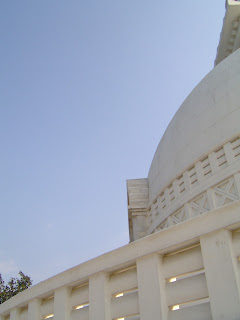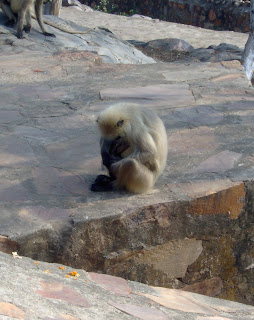Well, what's regular on this blog is up to me, but I suspect some folks would like to see more pretty pictures...or at least, interesting ones.
I took a day trip out to Rajgriha/Rajgir and environs; this is where Shakyamuni began teaching, turning the first wheel of the dharma and where his patron King Bimbhisara supported teacher and sangha. I would go back in a heartbeat and stay a day or two to experience some things in greater detail, not the least of which is the peak itself, and Venu Vana, the Bamboo Grove the king gave to Buddha and his community as a place to practice.
The latter part of the day was spent at Nalanda, one of the most amazing archaeological sites I've ever experienced. Nalanda University was the first university as we understand it, dating back to fifth century C.E.; it grew to a massive organization of 10,000 students and 1,500 instructors before finally succumbing to the ravages of the Moghul invasion. The site as it is comprises only a tenth of what still lies under farmland around the area. I don't know what the plans are for further excavation, but I hope that if they do carry out more digging, that anyone displaced is well provided for and the crop disruption is likewise offset.
We also checked out the Archaeological Museum which is a small collection but fascinating, not just of finds from the site itself, but from other areas, as well. Of note, to me was a ninth century small statue of Yamantaka in human form standing atop a water buffalo. In all other respects, Yamantaka looks like the buffalo-headed figure we commonly recognize; I am assuming that his human-headed version is an earlier iconography and that the buffalo he stands on top of was incorporated later.
Also, there were some interesting statues of Vajrapani seated like Vajrasattva and this leads me to suspect that Vajrapani, Vajrasattva and Vajradhara may all be splits from the same figure. I'll be looking into this for my own edification while I'm here in India. The Vajrapanis in the museum are seated with the right hand holding the vajra upright and the left resting, palm up on the left leg. In Vajrasattva, we have the vajra being held at heart height in the hand with the left holding a bell in an upward facing palm. To be sure, Vajradhara typically has the hands crossed at heart level, holding dorje and bell.
One thing that was both perplexing and somewhat of an annoyance is the insistence that Padmasambhava attended Nalanda. I know of no supporting literature for this claim and assume it's based on Padmansambhava's association with Shantarakshita who requested Padmasambhava's presence in Tibet to quell the disturbing forces that were providing obstacles to the establishment of Samye monastery (and Buddhism, overall) there. If anyone has any documentation on this, I'd like to hear/see it.
With no further ado, here we go:
Part 1: Rajagriha
 |
| Not easy to make out but in this sandstone stretch are distinct grooves which they say are ruts that came from Krishna's chariot. Our guide said that archaeologists are still puzzling this out. The most accepted theory is that these are ruts that were worn into the rock over a period of decades (centuries) by chariots that were conveying supplies from place to place. |
 |
| This and the following photo are examples of a still-untranslated script. According to our guide, it's proposed that it may some form of a Dravidian language. A cursory glance reminds me of Tibetan u-mey script. Apparently, it's neither but seems fairly common around different sites in Central India. Update: this is called "conch script", or shankha lipi (old Javanese). And yes, apparently, it has been translated. Who can you trust these days? |
 |
| Here and below, the tracks are more pronounced. |
 |
| Here is the site for the Jivakrama, the greatest physician of Buddha's time. |
 |
| From the chair lift to the Peace Pagoda! Not as fast a zip-line and a bit rickety, but walking would have entailed a lot more time. |
 |
| A view from the lift. |
 |
| The Peace/Shanti Pagoda donated and built by Japanese Buddhists in 1958. Very lovely. |
 |
| This is a familiar statue that see in a lot of Far Eastern Buddhist traditions re-enacting the infant Siddhartha's trodding his initial steps to proclaim that this would be his last incarnation. My friend Tsering Ngodup called it "Buddha Hailing a Taxi"..... |
 |
| Here and below: Maha Kassapa/Mahakasyapa's cave. One of the Buddha's senior disciples meditated here and came here to recover from illness. |
 |
| In addition to "om mani padme hung", there's also "karmapa kyeno" (Karmapa , hear us!) Sectarianism at what should be the least sectarian site, he sniffs. |
 |
| Views from Vulture's Peak. I didn't want to take pictures of the little shrine they have set up from where Shakyamuni is said to have originally preached because there was a group of Thai people listening to a dhamma talk. This does give you a good idea of why he stayed and taught here, though. |
 |
| On the way back down. |
....and monkeys. Just 'cause......
Coming next: Part 2, Nalanda































No comments:
Post a Comment